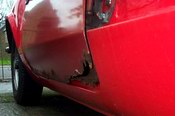
These are my notes taken at the time when I first got the Spitfire into a garage with a view to having the necessary work done. The ticks mark the items that were fixed at once: most of the items marked with a red cross have since been done.
Summary of conversation with Dave at the Classic Sports Car Workshop on 24th January 1999
Issues that need to be dealt with.
 The temperature gauge is not working, possibly because the thermostat has been removed. The radiator is very silted. Repair cost: £25, provided there is nothing too serious. If a new radiator is needed it’s about £100.
The temperature gauge is not working, possibly because the thermostat has been removed. The radiator is very silted. Repair cost: £25, provided there is nothing too serious. If a new radiator is needed it’s about £100. The driver’s seat back is broken. Cost to open it up and re-weld it: £75
The driver’s seat back is broken. Cost to open it up and re-weld it: £75 The engine bearings are rattling due to wear – the crankshaft needs grinding and the bearing changing. This would be a much bigger problem if the thermostat was working as the engine would be hotter and the oil therefore thinner. Cost to fix (involves removing the engine) is £400. This is the worst-case scenario and we may be lucky and get away with £250-£300. But we probably won’t be. However, because the engine is being removed it reduces the labour cost of other tasks that might otherwise be too expensive.
The engine bearings are rattling due to wear – the crankshaft needs grinding and the bearing changing. This would be a much bigger problem if the thermostat was working as the engine would be hotter and the oil therefore thinner. Cost to fix (involves removing the engine) is £400. This is the worst-case scenario and we may be lucky and get away with £250-£300. But we probably won’t be. However, because the engine is being removed it reduces the labour cost of other tasks that might otherwise be too expensive. The middle is dropping, due to inadequate work on the replacement sills. Corrosion around some of the key load bearing areas (eg seat belt fixings, seat base). Difficult to see how it got through its MOT like this. Cost to fix: £150 – £200 if leaving the metal with primer only, £300 with a respray. This would probably also fix the door hang.
The middle is dropping, due to inadequate work on the replacement sills. Corrosion around some of the key load bearing areas (eg seat belt fixings, seat base). Difficult to see how it got through its MOT like this. Cost to fix: £150 – £200 if leaving the metal with primer only, £300 with a respray. This would probably also fix the door hang. Corrosion on the off-side chassis front – not a problem at the moment
Corrosion on the off-side chassis front – not a problem at the moment The new hood currently stored in the boot is of a very high quality, reducing the labour cost to fit. £50.
The new hood currently stored in the boot is of a very high quality, reducing the labour cost to fit. £50. One of the exhaust mounts is rubber, not metal, and the exhaust is dropping. The gasket is blowing. £15.
One of the exhaust mounts is rubber, not metal, and the exhaust is dropping. The gasket is blowing. £15. The boot floor and rear valence need cutting out and replacing – but this can wait. Estimated cost: £600, maybe a bit more if the rear wings turn out to need work too.
The boot floor and rear valence need cutting out and replacing – but this can wait. Estimated cost: £600, maybe a bit more if the rear wings turn out to need work too. The bonnet has new wings but the underside arches are not properly fitted. Of academic interest only.
The bonnet has new wings but the underside arches are not properly fitted. Of academic interest only. The front brake hoses are old and the rear ones are not too clever either. The pedal is sloppy and the discs and pads need changing. Cost: £215.
The front brake hoses are old and the rear ones are not too clever either. The pedal is sloppy and the discs and pads need changing. Cost: £215. Both rear universal joints have a bit of play. This is not critical and they are not too noisy – unless the rattling exhaust was drowning them out. They tend to go every year or so anyway. Cost: £160. Might be a good thing to do in six months.
Both rear universal joints have a bit of play. This is not critical and they are not too noisy – unless the rattling exhaust was drowning them out. They tend to go every year or so anyway. Cost: £160. Might be a good thing to do in six months. Tyres are all remoulds – so no motorway driving. They all look legal, though he didn’t look at the spare. Cost for five new ones (ie non-remould) is about £200.
Tyres are all remoulds – so no motorway driving. They all look legal, though he didn’t look at the spare. Cost for five new ones (ie non-remould) is about £200. The differential is part worn – no problem
The differential is part worn – no problem Conversion to non-Waxstat jets in the carbs would be a good idea. Cost to fully re-fit and convert: £200.
Conversion to non-Waxstat jets in the carbs would be a good idea. Cost to fully re-fit and convert: £200.
Other stuff that’s being done or might be wise in the future:
 Service: halved in price to £75 because the work being done covers lots of stuff that’s part of the service. During this they will look at the engine oil leak (lots of gaskets are changed anyway) and also fit the fuel gauge petrol tank mechanism.
Service: halved in price to £75 because the work being done covers lots of stuff that’s part of the service. During this they will look at the engine oil leak (lots of gaskets are changed anyway) and also fit the fuel gauge petrol tank mechanism. Replacing the clutch for £75 – £100 less than normal because the engine’s coming out anyway.
Replacing the clutch for £75 – £100 less than normal because the engine’s coming out anyway. There’s a year left in the gearbox. A reconditioned one costs £200 if the engine’s already out, £250 or so if it’s not. Overdrive gearbox is about £600.
There’s a year left in the gearbox. A reconditioned one costs £200 if the engine’s already out, £250 or so if it’s not. Overdrive gearbox is about £600. Locks are historically dodgy and offer no real security anyway, so not worth replacing. Not even worth locking the door when you leave the car. About £200 to replace the locks – spend the money on a bloody great crook-lock instead.
Locks are historically dodgy and offer no real security anyway, so not worth replacing. Not even worth locking the door when you leave the car. About £200 to replace the locks – spend the money on a bloody great crook-lock instead. Fitting a tubular exhaust manifold is not a bad thing to do – a mild steel one costs about £125, will prevent trouble later with the exhaust, and is easier to fit now than later.
Fitting a tubular exhaust manifold is not a bad thing to do – a mild steel one costs about £125, will prevent trouble later with the exhaust, and is easier to fit now than later.
To do the ticked work (a list decided to be most urgent or convenient by mutual agreement) he was asking £1,250 plus VAT, for a total according to my calculations of £1,468.75.
